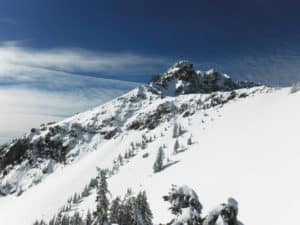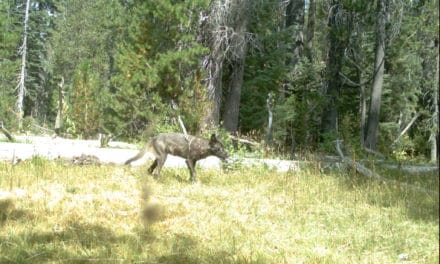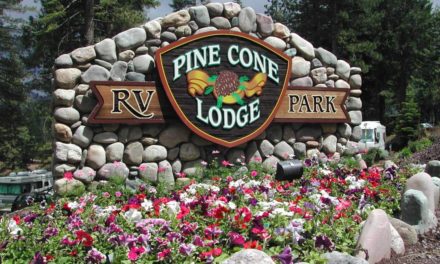Breaking Into The Backcountry
With Mark Underburg and Daniel Dobyns
By Mara Dobyns

With perfectly good ski resorts around one might question why anyone would want to go into the backcountry in the first place. For others that question might be, why not? For Daniel Dobyns it was the only logical option. “I first started going into the back- country when I was fourteen. My mom and dad didn’t want to buy a season pass and if you wanted to go snowboarding you had to go hike. You had to put yourself out there to do it. I just wanted to snowboard.”
For Mark Underburg it’s much more serene than the generally crowded resorts. “It’s a lot more peaceful. It’s better than dealing with a lot of people. The reason I got into it is because I enjoy life out there in the backcountry.”
Daniel added, “It definitely evolved when I moved here. You never know when Coppervale (a local ski and snowboard hill) is going to open. You know that even in a bad year Lassen National Park will generally have plenty of snow. Sometimes you just can’t afford the gas, food, money, passes, and unexpected expenses of going to a ski resort. It’s nice to know that if you have the equipment you can still go snowboard.”
Mark amitted, “It’s a challenge.”
Dan added, “Yeah, there’s never a dull moment. No matter how many times you’ve been to an area it’s a challenge because you have to pay attention to so many different variables. It may be the same hill and the same mountain that you’ve done 30-40 times before but there’s always something potentially different about it.”
When I ask Dan and Mark if they would recommend snowboarding in the backcountry to other people they agree: “Of course!” If you’ve got some stress going on, he says it’s nice because you don’t think about it out there.” Mark adds, “Whether you’re a snowboarder, skier, or you’re snowshoeing it’s just fun. Some-times you get to take some turns that nobody has ever taken before.”
Is the snow better than what you would get at a resort? “At a resort you can get fresh snow if you take the right lifts but you don’t get it all day. Eventually someone else will have ridden it. You go up to Lassen and you pass tracks but it’s not blown out. We call it the chunder. That’s a term me and my friends have had for a while. It gets so choppy and nasty that it’s more of a workout. When you’re in the backcountry it’s like you have your own canvas.”
There’s a lot of preparation that goes into planning a day in the backcountry. It all just depends on what kind of day you want. “I’ve gotten up at three in the morning before,” Dan said. But before any day is planned you have to scout out which day will be best. “The first thing I do is pull up the weather online. It’s the most important thing. You need to know what the weather is doing. You need to be paying attention to the snow and snow conditions during the entire winter.” Especially when it’s new snow because that means there’s a higher probability for avalanches.
Will there be days where it’s just miserable? Of course there will be. “We were out in eighty-mile-an-hour winds with snow. You have those moments where you’re thinking no one’s going to care if I don’t go to the top today.” But you push through it, Dan said. “A lot of times like that day it was a new area. I wanted to see it. So I told myself I’m going to make it up there.”
If you’re thinking about planning your first adventure into the backcountry, equipment as well as the buddy system should be at the top of the list. Don’t go unprepared. Make sure you have the right gear. You’re going to need a shovel, beacon, and probe just in case of an avalanche. The probe has multiple uses; it’s not just for worst case scenarios. “I use the probe for a lot of things. A lot of times if I’m on top of Brokeoff Mountain there’s a really big cornice that forms at the very top, and before you walk off the edge I’ll shove my probe in until I hit the ground so I know that I’m not over the cliff.”
There are more high-tech systems that can be purchased like A.B.S. which is an airbag that pops out of your backpack and keeps you on top of the snow in case of an avalanche.
“Bring a buddy, wear a helmet and take a safety course. Have the experience, but be educated. It’s not just walking into the woods. It’s the wilderness, you can be injured or die out there. You don’t have to be on the hill for an avalanche to make it to the flats. Let someone that knows the area know where you’re going. Lassen National Park has a volunteer ski patrol; tie in with them. They’ll tell you good information. Not only is it nice for them to know where you’re at they’ll tell you what they’ve been seeing; if there’s been activity somewhere, and they may even tell you where the hidden pockets are that people haven’t found yet.”
You can even purchase something called a split board. A split board comes apart in the middle like skis, which is much easier for hiking and then latches back together when you’re ready to ride.
Remember, you can never be too educated in the backcountry. Make sure to get permission if you are on private land.
For more information on gear or safety basics click on these links: www.snowshoes.com/learn/article/avalanche-safety-basics; www.backcountry.com/avalanche-safety.












